Video
Development from 24 to 36 Months (Cantonese version with English subtitles only)
Title:Development from 24 to 36 Months
Heading: Development from 24 to 36 Months
Scene: Two girls are playing toys. One of them takes a toy telephone and pretend speaking on the phone.
Girl: Telephone! Hello! Telelphone …. Hello Hello!
Scene: the other girl puts plastic rings through a plastic pole from small to big.
Narrator: After the second birthday, you will see significant progress in all aspects of your child's development.
Scene: The girl takes the toy telephone and pretends that the telephone is ringing.
Girl: Hello, grandma.
Scene: The other girl play the toy piano attentively.
Scene: A group of two to three years old children run in the park.
Narrator: Children at this age are energetic and active. They can run fast,
Scene: A group of children are playing football in the park. A child kicks a stationed ball. He chases and tries to kick the rolling ball.
Narrator: kick balls,
Scene: Two children are playing with playground equipment. They jump down from a low step landing on both feet. One girl climbs up the climbing frame in the park carefully.
Narrator: jump and climb well,
Scene: A girl walks up the stairs one foot on each step carefully without holding the handrails. Another girl also walks down the stairs carefully with two feet on each step without holding the railings.
Narrator: walk up and down stairs without any help
Scene: A girl rides a tricycle easily. She pedals the tricycle forward and make a turn.
Narrator: and ride tricycles.
Scene: A group of children are at the kindergarten classroom. A girl grasps a crayon and draws vertical and horizontal lines on drawing paper.
Narrator: For his hand and finger skills, he can draw vertical and horizontal strokes,
Scene: A girl stacks a tall tower by putting toy blocks on top of other. Another girl threads half-inch wooden beads with a piece of shoe lace. Another girl reads a book and turns page by page. Another child winds up the spring of the toy helicopter and lets the propellers turn.
Narrator: build simple models with bricks, thread beads, turn one page of a book at a time and wind-up toys.
Scene: A girl walks with her mother in a shopping mall.
Girl: I want to pee pee.
Mother: OK. I'll take you there.
Narrator: As for self-care skills, he no longer wet his pants during daytime.
Scene: A girl opens the paper wrap of the sweet and put it into her mouth. She uses a spoon to eat. She drinks water from a cup all by herself.
Narrator: He can feed himself more skillfully,
Scene: The girl puts on a small vest herself. Then she unzipped the front zip and takes off the vest.
Narrator: dress and undress simple clothing.
Scene: Several girls are playing shape matching game. They watch carefully and insert different shapes of blocks or English characters into the correct holes.
Narrator: Concerning cognitive development, his learning process becomes more thoughtful, and is capable of solving problems by thinking. His memory and attention span also improves, allowing more time for quiet play.
Scene: A girl sort small beads of two different colours and put them into two different baskets.
Narrator: He also begins to identify colours,
Scene: Two girls sort the wooden blocks according to their colours, red, yellow and green.
Narrator: and understand numbers.
Scene: A girl correctly counts the four wooden blocks on the table.
Scene: A child pretends cooking in a toy house with toy kitchen set.
Narrator: He becomes more elaborate in pretend play,
Scene: The girl put the toy tea sets and toy food on the tray. She imitates her mother to take food out from the kitchen to serve the others.
Narrator: like pretending to be a mum or doctor.
Scene: A boy puts on the toy stethoscope and imitates a doctor to examine a doll. Another girl imitates her mother to feed the doll milk.
Scene: The girl is having meal with her parents. The telephone rings.
Mother: The telephone is ringing. Go get me the phone.
Scene: The girl immediately goes to the other end of the sitting room and gets the phone for her mother.
Narrator: He can understand simple commands,
Mother: Thanks.
Scene: The girl is reading a book. The teacher points to the different pictures in the book.
Teacher: What is this?
Girl: This is sock. This is shoe.
Narrator: and answer simple questions.
Scene: The girl plays cooking set with her mother. The mother is holding a toy knife.
Mother: What is this?
Scene: The girl gets the toy knife from her mother.
Girl: Knife.
Mother: What is knife used for?
Scene: The girl takes a look at her mother.
Girl: cut
Scene: Then she pretends to cut the toy food with the toy knife.
Scene: The girl and mother are reading a book.
Mother: What colour Is it?
Girl: Yellow.
Mother: Oh, the camel is yellow, is it?
Scene: A girl and her mother are at the playground. She stops in front of the merry -go-round and looks at her mother.
Girl: Mother, I want to ride this.
Narrator: He speaks simple phrases or sentences,
Scene: The girl is at the restaurant. She is holding a candy.
Girl: Let's have candy
Scene: The girl is in the sitting room.
Narrator: begins to use pronouns,
Girl: Mammy, I am hungry. Did you cook rice?
Scene: The girl is eating with her brother at the restaurant.
Girl: How many you ate?
Scene: The girl is having dinner with her father. The girl points to pictures of food printed on the table.
Narrator: and likes to ask questions,
Girl: What is this?
Father: This is dumpling.
Girl: How about this?
Father: This is also dumpling.
Scene: A girl plays swinging horse by herself in the park. Then she plays seesaw with another girl.
Narrator: For his social development, although still self-centered, he begins to enjoy playing with familiar playmates.
Scene: Two girls are playing seesaw and two children come and line up for their turns.
Narrator: He starts sharing and taking turns when playing games.
Scene: In the park, a boy cries suddenly. A girl follows him and start crying. Another girl comes forward to see what is going on and dries the boy's tear.
Narrator: He would cry,
Scene: A boy has temper tantrums and throws away the ball which his mother gave him.
Narrator: throw tantrums, or display rebellious behavior when frustrated.
Scene: The parents bring their daughter to kindergarten. The girl cries on the way. She doesn't want to leave her parents. The parents hand the girl to the teacher and say goodbye to her.
Father: Listen to the teacher. Don't be naughty.
Narrator: Attending nursery or kindergarten, provides a chance for him to interact with others, and to acquire different knowledge. Although it may take some time for him to adapt, he would discover and enjoy the activities there in due course.
Scene: The girl calms down, waves bye bye to her parents and says goodbye.
Scene: Many children photos are displayed on the screen.
Narrator: Parental involvement and support is of utmost importance, to facilitate a child to develop to his full potential. You can provide an interesting and safe environment, as well as toys and activities that are appropriate for his age, to help him learn and explore. Spend more time talking with him, and encourage him to express himself in language. Pay attention, and respond warmly and contingently to his behavior. He needs your guidance. Give him room to explore while establishing some rules. Allow him to make mistakes within safe boundaries. But most important of all, have reasonable expectations for your child's abilities. With your understanding and guidance, your child will grow healthily and happily. If you have any concerns or queries about your child's development, please contact any Maternal and Child Health Centre of the Department of Health or other health professionals.
Both nature and nurture affect every child's development. While nature is important in determining your child's capabilities and abilities, the role of a nurturing environment is of equal importance in your child's learning, as well as social and emotional development.
Development is a continuous process and has a certain sequence that children would go through. However, parents should remember that every child is unique and they have their own pace in development and vary in their abilities. For example, some may have attained their milestone of speech earlier, while others may be more advanced in physical agility than their peers. When you find your child is behind in certain abilities, instead of being over-alarmed, pay more attention and encourage him to try. Seek for assistance from your Maternal and Child Health Centre when you have concern.
What You Can Do to Help Your Child's Development
What Child Can Do
What You Can Do
I am physically stronger and my mobility increases
I can jog.
I can kick a ball.

I can walk up and down stairs without any help.
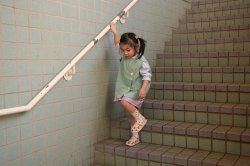
I can ride a tricycle.
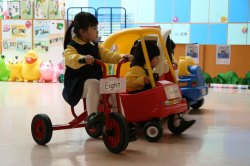
I can climb.
I need 3 hours of physical activities in a variety of ways, so take me outdoors and let me run, play ball, ride the bike and climb in the playground

Let me play with other children

My eye-hand coordination enables me to do more
I can build simple models with blocks.

I can draw vertical and horizontal lines.
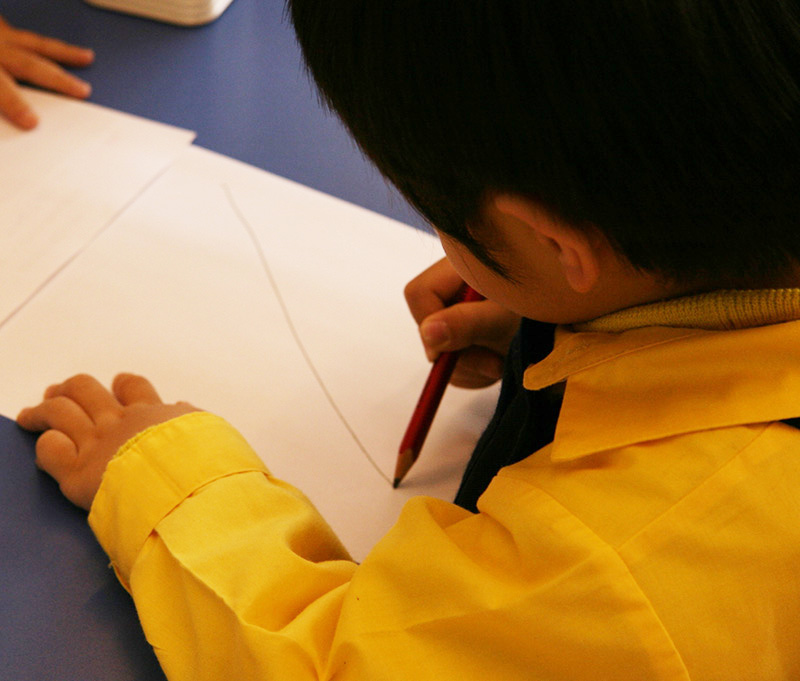
I can thread beads.

I can wind up toys.
Build blocks, draw and thread beads with me.
Chat with me and appreciate my creativity.
Give me some wind-up toys to play with.
I can recognize more things
I begin to understand the relationship between objects; therefore can solve jigsaws (3-4 pieces) and match objects and pictures.

I can identify several common colours, although I cannot name them.
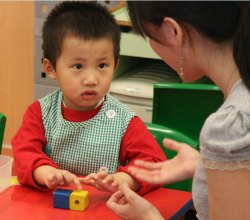
I enjoy pretending to be different roles I met in daily life, such as mummy or doctor.

I am imaginative. I will fantasize an object as another in play, such as stir-frying some blocks as food in a toy pan. I can even create new games.
Guide me to solve problems. For example: When solving jigsaw puzzles, teach me to put together the pieces of the same colours and pay attention to the shapes.

Creative Play
Title: Creative Play
Narrator: Creative play
Scene: Dad and Mum are playing with their daughter and son in the living room.
Narrator: Children explore and learn about their surroundings through play. Their creativity can be enhanced with their cognitive advancement. You can make use of playtime with them to foster their imagination and creativity.
Narrator: To do this, you don't need to use toys or high-tech products. There are lots of resources at home, as long as they are safe and non-fragile.
Scene: Dad, Mum and their kids are playing cushions.
Sub-heading: Imagination and creativity
Sub-heading: Turning ordinary to extraordinary
Narrator: Through children's imagination and creativity, household objects can be fun. For example, cushions may be used to build things, or as an imaginary car or for horse riding.
Scene: Kiki, the daughter, is holding a cushion and asks Dad to drive with her.
Narrator: Kiki gives Dad a cushion and asks him to pretend to be driving when he's sitting on the sofa.
Scene: Dad and Kiki are holding the cushions as steering wheels. They pretend driving a car on the sofa and Dad follows Kiki.
Narrator: Dad and Kiki are holding cushions as steering wheels.
Scene: Kiki stands up and goes around the living room, Dad follows.
Narrator: Kiki is driving around the living room, Dad follows her.
Scene: Mum is reading on the sofa, Kiki says she wants to play princesses.
Narrator: Mum is reading on the sofa, Kiki asks her to play princesses together.
Scene: Mum uses a scarf as a long dress.
Narrator: Mum uses a scarf as a long dress.
Scene: Mum gives Kiki a plastic bottle as a microphone to sing.
Narrator: Mum gives Kiki a plastic bottle as a microphone to sing, and they enjoy their time together.
Scene: After singing, Kiki returns to the sofa and Mum praises her.
Scene: The family is playing in the living room. Dad and the kids are doing lion dance using a scarf.
Narrator: Dad and Mum are playing with their kids. Chris and Dad are doing a lion dance using a scarf. There can be lots of fun with a scarf!
Scene: The family is pretending to fight monsters by using cushions and plastic bottles.
Narrator: Dad, Mum and the kids are pretending to fight monsters by using cushions and plastic bottles. See how excited they are!
Sub-headings: Parents' participation
Narrator: Your participation is very important. Engage in your child's imagination and creativity.
Sub-headings: Children take the lead
Narrator: Let them take the lead when it is safe to do so and appreciate their creativity.
Scene: The family is taking some plastic bottles and a small basketball to the living room. They are going to play bowling.
Narrator: Dad is taking some plastic bottles and a ball to the living room. He is going to play with Mum and the kids.
Scene: Everyone takes turns to roll the ball towards the bottles. They are so happy when the ball strikes the bottles.
Narrator: Everyone takes turns to roll the ball towards the bottles. They are so happy when the ball strikes the bottles.
Scene: Mum and her kids are playing with a kitchen playset.
Narrator: Sometimes, children may play games in their own way. Kiki and Chris put the toy pots and bowls on their heads as hats when they are playing with the kitchen playset. Mum follows.
Sub-heading: Correct demonstration
Narrator: If you worry that your child might mix up the use of objects, you may show them the correct use in other situations.
Narrator: See? Mum pretends to cook using the kitchen toys with her kids.
Scene: Dad and Mum are playing with their kids.
Narrator: Parents! Remember to be involved, respond and appreciate your children's creativity. At times, you may guide them in adding new ideas. Your support and encouragement is important for nurturing their imagination and creativity.
End Shot: Department of Health logo
The Department of Health owns the copyright of this digital video.
This digital video is produced solely for non-commercial use.
It should not be rented, sold or otherwise used for profit-making purposes.
Be creative and imaginative! Then you will help to breed my originality. For example: Cushions can be used in various ways in play, like building a house or a tunnel, playing yachting, horse riding, serving dinner …

Engage in my games and get involved. Follow my lead and appreciate my creativity.

I understand more and speak better
I can understand simple and two-step commands, e.g. “Put the ball into the box”
I can understand and say different verbs and adjectives, e.g. “open” and “hot”
I am capable to speak short sentences, e.g. John eats cookies.
I can use pronouns appropriately, e.g. “I” and “You”
I can answer simple questions and like to ask “What is this?”.
You can ask me questions and encourage me to express my needs.
Ask me close-ended questions that yield “yes/ no” answers. When I know more words, you can ask more open-ended questions such as “What do you want for breakfast?”
I can get on with others better
I like to imitate actions of other kids or adults.
I learn to wait and share.

I am still self-centred.
Teach me to share and take turns through daily activities and playtime with friends.
Refer to “Making Friends” Leaflet

My emotions are more complex
My emotions go ups and downs. I may throw tantrums and disobey commands often.
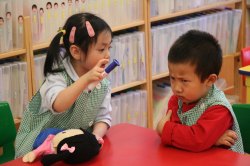
At the same time, I am aware of others' feelings and even have empathy on others.
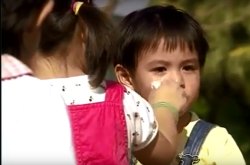
Understand that I begin to have my own thinking but my self-control is still weak. Sometimes I just want to see whether you would do as you said and I do not mean to disobey you.
Be my role model for learning to be caring.
I can learn about empathy from you when you put yourself in my shoes or others' shoes.
Teach me the feeling words, e.g. “happy”, “angry”, “miss (something or someone)”.
Nurturing Virtues and Values in Children
Title: Nurturing Virtues and Values in Children
Narrator: Nurturing virtues and values in children
Scene: When entering children's playroom, Mrs. Lee reminds Kiki to take off her shoes and put them on the shelf. Mr. Wong teaches Hinz to take turns if he wants to play. Chris jumps the queue for playing on the slide; Mrs. Wong stops him and asks him to queue up.
Narrator: It is essential to start nurturing virtues and values in young children so that they can do the right things and be nice to people around them. It will also contribute to their success in the future.
Narrator: From 2 years old, children learn to think from others' points of view. We can make use of every opportunity in daily life to develop such ability according to their developmental level. Being their role model, it is important in instilling them with good virtues and values.
Heading: Respect Others
Narrator: Respect others
Scene: The Wongs meet Mrs Lee and her daughter, Kiki, in the children's playroom. They greet each other.
Narrator: Just like Mr. and Mrs. Wong, they respect people and are caring and polite. They greet their neighbours, Mrs. Lee and her daughter, at the children's playroom with their son.
Scene: When Mrs. Lee and Mrs. Wong are chatting, Chris pulls Mrs. Wong's hand. Mr. Wong asks Chris to stop.
Narrator: Chris wants to go and keeps pulling his Mum's hand while she is chatting with Mrs. Lee.
Narrator: Seeing Chris keep pulling Mum's hand, Mr. Wong tells Chris to respect others and to wait until they finish talking.
Heading: Care and Empathy
Narrator: Care and empathy
Scene: Kiki and Chris are playing in the playroom while their parents are chatting nearby. Hinz tripped over and fell down.
Narrator: Kiki and Chris are playing in the playroom. Suddenly, a boy trips over and falls down.
Scene: Chris laughs at the boy but Kiki offers help to him.
Narrator: Chris laughs at the boy but Kiki offers help to him.
Scene: Mrs. Lee smiles at Kiki and gives her a thumbs-up.
Narrator: Mrs. Lee smiles at Kiki and gives her a thumbs-up.
Scene: Mr. Wong talks with Chris.
Narrator: Mr. Wong asks Chris if he would like others to laugh at him if he is the one who trips.
Narrator: Chris shakes his head in response.
Heading: Sharing and Cooperation
Narrator: Sharing and cooperation
Scene: Chris, Kiki and Hinz have lots of fun. Kiki is sharing her stickers with them.
Narrator: Kiki shares her stickers with Chris and Hinz.
Narrator: The boys are so happy when they receive the stickers.
Narrator: It is good that children learn to share.
Heading: Cultivate Social Responsibilities
Narrator: Cultivate social responsibilities
Scene: Chris takes out some snacks from his pocket. Kiki and Mrs. Lee tell him that he should not eat in the playroom.
Narrator: Chris takes out some snacks from his pocket to eat in the playroom. Kiki and Mrs. Lee stop him and draw his attention to the sign of ‘No eating'.
Narrator: Helping children to obey rules in public places is important.
Heading: Develop Self-control
Narrator: Develop self-control
Scene: Chris, Kiki and Hinz are playing together.
Narrator: Children have difficulties in controlling their impulses and lose their temper easily. One thing you can do, is to help your child develop her self-control.
Scene: Kiki has just got down from the slide. Mrs. Lee tells her that it is time to go home.
Narrator While Kiki is having a wonderful time in the playroom, Mrs Lee tells Kiki it's time to go home.
Scene: Kiki refuses to go home. She starts to throw a tantrum and stamp her feet.
Narrator: Kiki refuses to leave. She keeps stamping her feet.
Scene: Mrs. Lee takes her aside and teaches her to take deep breaths to calm herself down.
Narrator: Mrs. Lee takes her aside and teaches her to take deep breaths to calm herself down.
Scene: Mrs. Lee praises Kiki for calming down.
Narrator: Finally, Kiki calms down, and Mrs. Lee praises her. Then, they go home together.
Scene: Children are playing orderly in the children playroom.
Narrator: To foster your child's self-control, your persistent effort with the child is important!
End Shot: Department of Health logo
The Department of Health owns the copyright of this digital video.
This digital video is produced solely for non-commercial use.
It should not be rented, sold or otherwise used for profit-making purposes.
Produced in 2015

